#namib web-footed gecko
Text

Palmated gecko (Pachydactylus rangei)
Photo by Emanuele Biggi
#Pachydactylus rangei#Pachydactylus#gecko#palmated gecko#reptiles#lizards#purple#namib sand gecko#namib web-footed gecko#african lizards#african geckos#namib desert#southern africa#nature#animals#wildlife
12 notes
·
View notes
Text
Namib Sand Geckos: these nocturnal geckos have biofluorescent markings that emit a bright, neon-green glow when exposed to the moonlight

This species (Pachydactylus rangei) is found only in the Namib Desert, which stretches across Namibia, Angola, and South Africa; the geckos typically inhabit the arid, coastal region known as the Skeleton Coast.
In order to escape from the blistering heat of the desert, they use their webbed feet to burrow down into the sand during the day, and then emerge only at night, when the temperature has finally dropped. The webbing on their feet also enables them to run more easily across the dunes.
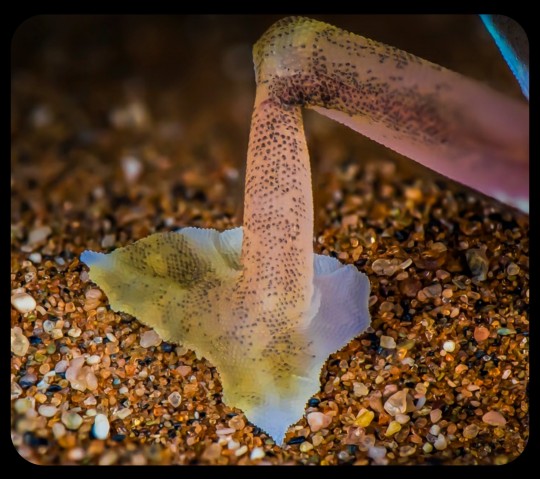
Namib sand geckos are covered in translucent scales, but they also have a strangely colorful appearance, as the colors/shades of their circulatory system, spinal column, internal organs, and optical membranes remain partially visible through the skin, producing various shades of pink, dark blue, purple, magenta, orange, and yellow.
They also have several distinctive markings running along their lower flank and encircling their eyes; these markings are known to fluoresce when exposed to UV light (including moonlight), emitting a bright, neon-green glow.

Some researchers have theorized that the biofluorescent markings may act as a signal to other geckos, allowing them to locate one another in the vast, desolate expanse of the desert, as this paper explains:
The fluorescent areas of P. rangei are concentrated around the eyes and along the lower flanks. This positioning is practically invisible to predators with a higher perspective (e.g. birds and jackals), but highly conspicuous from a gecko’s perspective. As P. rangei is sociable but generally solitary, and occurs at low population densities, such a signal might serve to locate conspecifics over greater distances ...
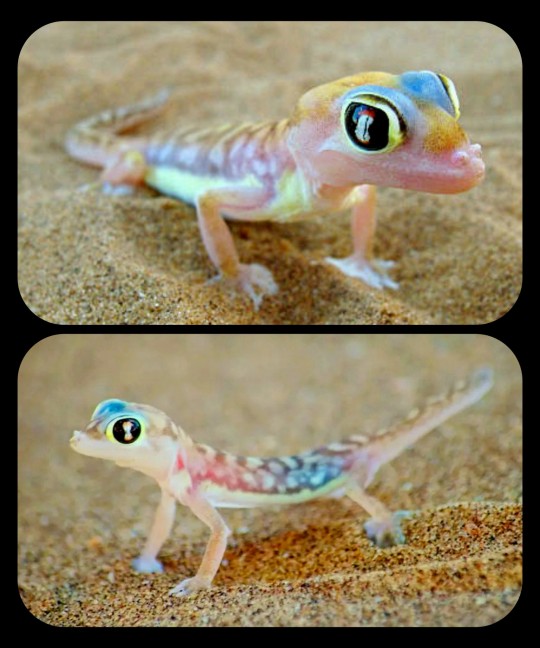
Encounters in P. rangei might serve purposes beyond mating opportunities: as the Namib desert has extremely low precipitation, fog is a key water source for its flora and fauna. Fog condenses on the bodies of the geckos, and they lick it from their faces. In husbandry, we have observed individuals licking water from conspecifics, taking advantage of a much greater available surface area.
Additionally, after short periods of isolation, the geckos run to meet each other. The combination of vital hydration with socialisation might reinforce signals that enable such meetings, and the cost of visibility to predators with higher vantage points, might constrain the signals to regions best visible from eye-level and below.
The Namib sand gecko is the only terrestrial vertebrate that is known to use an iridophore-based form of biofluorescence (you can find a more detailed explanation of that mechanism in the article mentioned above). The fluorescent dermal markings are also unique to this species.
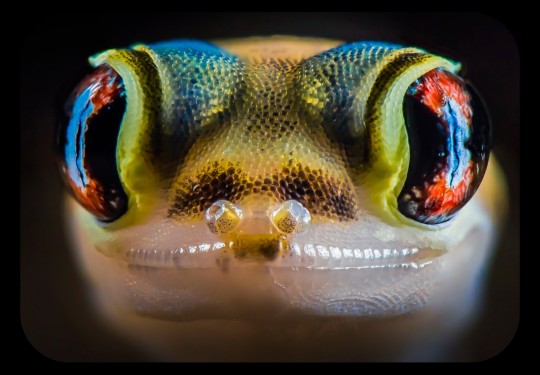
Sources & More Info:
Scientific Reports: Neon-green fluorescence in the desert gecko Pachydactylus rangei caused by iridophores
Animal Diversity Web: Pachydactylus rangei
Dr. Mark D. Scherz's Blog: A Neon-Green Glowing Gecko!
Australian Geographic: Skeleton Coast - Namibia's strange desert dwellers
#herpetology#reptiles#gecko#Pachydactylus rangei#namib sand gecko#palmatogecko#namib desert#namibia#biofluorescence#animals that glow#lizards#cute animals#biology#nature#africa#squamata#web-footed gecko#cool animals#geckos#South Africa#Angola#Skeleton Coast#wildlife#not an arthropod#but still pretty cool
173 notes
·
View notes
Text

Namib Web-Footed Gecko (Pachydactylus rangei), family Gekkonidae, South Africa
photograph by Paul Bester
214 notes
·
View notes
Text

more in my wheelhouse:
quick scraggly go at my character for a short term ICON campaign, Ginkgo Thunderheart II (she/they)! She's a seeker/spellblade, and also a little freak who does hit-and-run combat with a. A top. A spinning top. A beyblade if you will
she doesn't actually stand like that, but she is based off a Namib web-footed gecko and they fucking Do so i had to pay my respects.

27 notes
·
View notes
Note
Trick or treat trick or treat :D !!!!!!
You get 1 (one) Pachydactylus Rangei, aka Namib Web-footed Gecko!

1 note
·
View note
Text

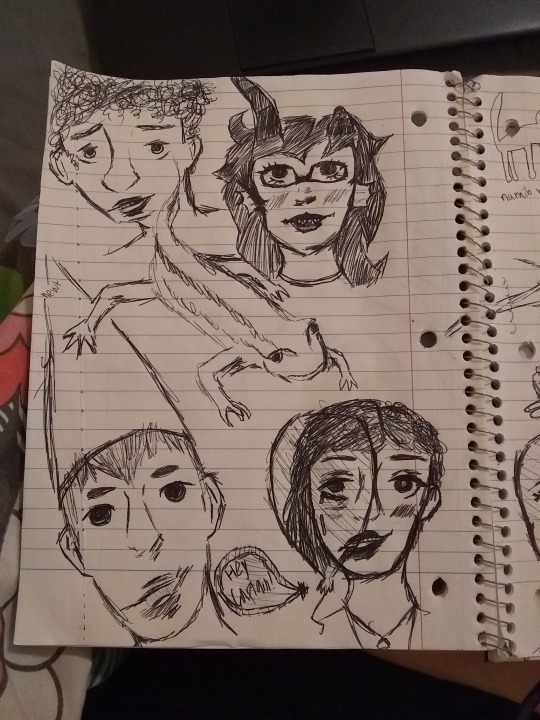

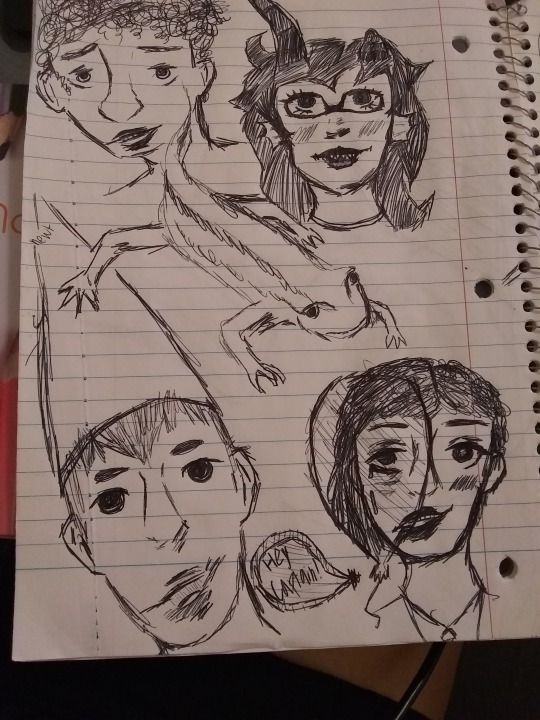
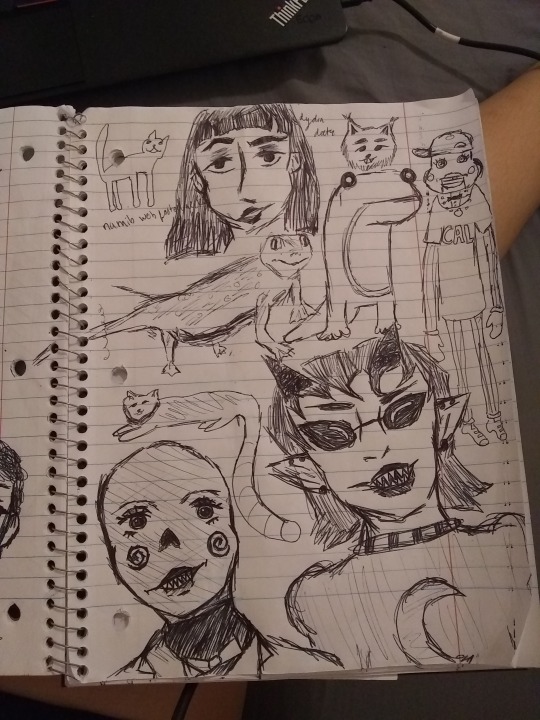
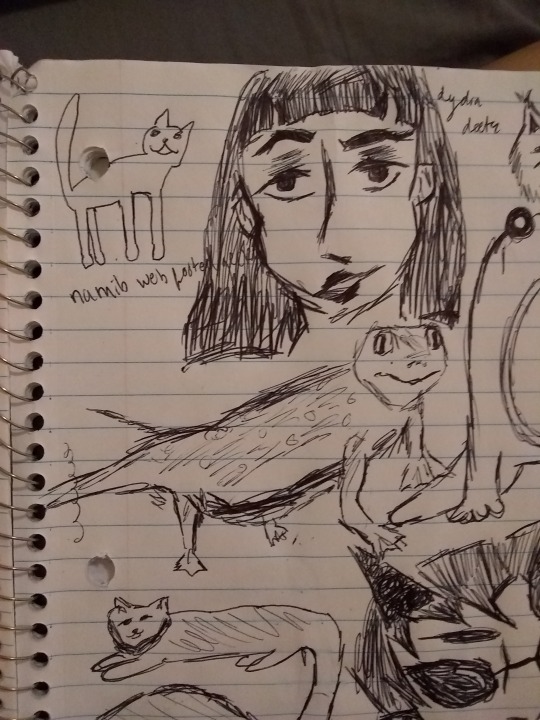
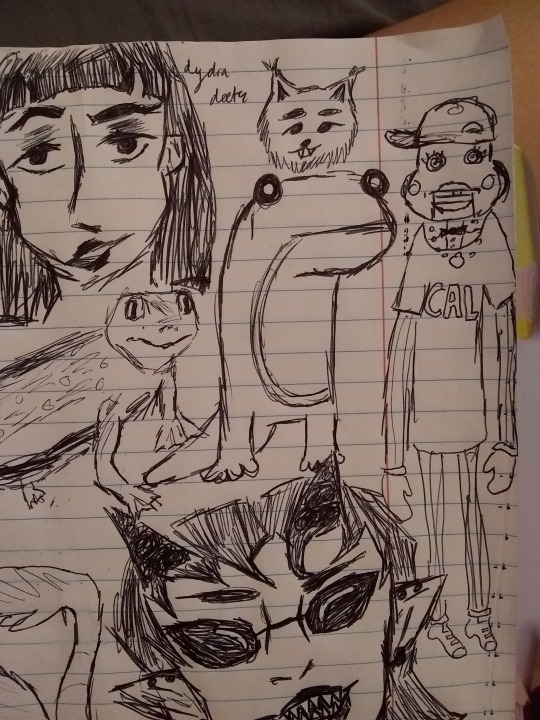


drawpile from today,,
#traditional art#art#traditional drawing#drawing#wybie#wybie lovat#coraline#fefetasprite#homestuck#newt#wirt#over the garden wall#otgw#it#it movie 2017#beverly marsh#drawpile#cat#cats#namib web footed gecko#lydia deetz#beetlejuice#beetlejuice the animated series#casey#casey the salamander#lil cal#calliope#terezi pyrope#prospit dreamer#god tier
31 notes
·
View notes
Text
dsmp endermen and c!ranboo r geckos. they literally geckos,,,,idk what the other half of ranboo is the the enderman half is gecko,, proof?? neither geckos nor c!ranboo have eyelids. for leopard geckos at least, they hate water and get very stressed out by it. cc!ranboo has said that c!ranboo has hair, and actually! geckos can grow hair, although usually on their toes for gripping surfaces, they have hair! maybe ranboo just evolved to also have some fringe, just for fun. namib web footed geckos glow under moonlight,,, so do endermen eyes,,, endermen r just strange geckos from the end case closed
#dsmp headcanon#c!ranboo#ranboo headcanon#i spent like 30 mins researching geckos just to make this post#this is /hj
14 notes
·
View notes
Video
youtube
One of the most beguiling creatures on earth, the Namib dune gecko, otherwise known as the palmato gecko or web-footed gecko, is a lot tougher than it appears to be. This small desert reptile, which only grows to about 13cm long, is in fact supremely adapted to its arid environment – so specialised that it only occurs in the Namib Desert. The skin of this gecko has a translucent look, with some of the internal organs almost visible beneath its surface, creating an illusion of ghostlike fragility, while delicate salmon undertones and light brown markings add to its visual appeal.
The most outstanding feature of the Namib dune gecko are its big, appealing, unblinking eyes which are lidless, like those of all geckos. As a nocturnal animal, these large eyes give it a panoramic view of its surroundings. The gecko has also learnt to take advantage of the constant fog in these parts, harvesting water from the atmosphere by allowing moisture to condense on its large eyeballs. Once a few drops have accumulated, the gecko licks its eyes clean with its tongue to claim this precious liquid as its own.
-------------------------------------------------------
Eine der spannensden Kreaturen der Welt, der Namib-Dünengecko, auch bekannt als Palmato-Gecko oder Schwimmfuß-Gecko, ist viel widerstandsfähiger, als es den Anschein hat. Dieses kleine Wüstenreptil, das nur etwa 13 cm lang wird, ist tatsächlich hervorragend an seine trockene Umgebung angepasst – so spezialisiert, dass er nur in der Namib-Wüste vorkommt. Die Haut dieses Geckos hat ein durchscheinendes Aussehen, wobei einige der inneren Organe unter ihrer Oberfläche fast sichtbar sind, was eine Illusion von geisterhafter Zerbrechlichkeit erzeugt, während zarte lachsfarbene Untertöne und hellbraune Markierungen zu seiner Attraktivität beitragen.Das herausragendste Merkmal des Namib-Dünengeckos sind seine großen, ansprechenden, nicht blinzelnden Augen, die wie bei allen Geckos ohne Lider sind. Als nachtaktives Tier geben ihm diese großen Augen einen Panoramablick auf seine Umgebung. Der Gecko hat gelernt, den ständigen Nebel in diesen Teilen zu nutzen, indem er die Feuchtigkeit auf seinen großen Augäpfeln kondensieren lässt. Wenn sich einige Tropfen angesammelt haben, leckt sich der Gecko mit der Zunge die Augen sauber, um das kostbare Nass für sich zu nutzen.

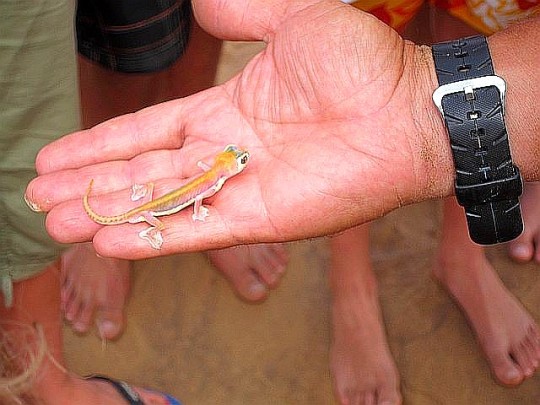


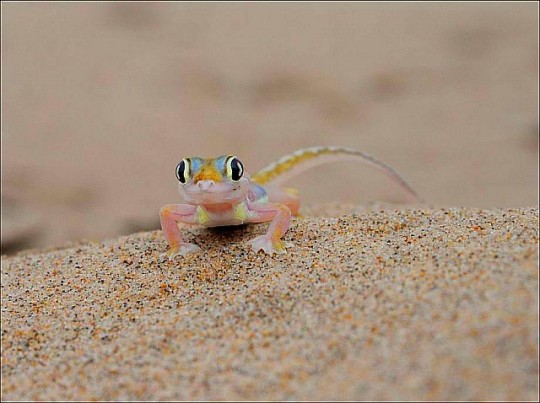

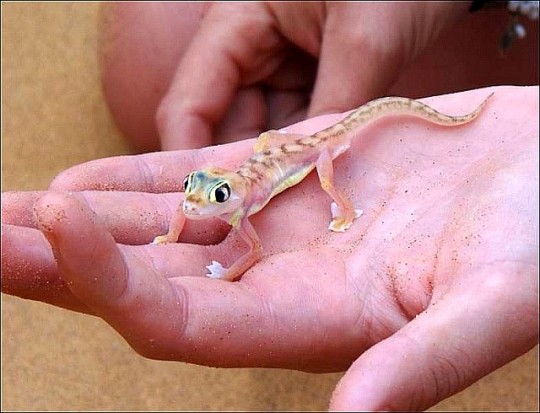




5 notes
·
View notes
Photo

Credit: David Prötzel
Glowing gecko. This baby Namib web-footed gecko (Pachydactylus rangei) fluoresces under ultraviolet light. The intense neon-green and blue glow — among the brightest fluorescence in any vertebrate — is produced by modified pigment cells called iridophores. Why many animals fluoresce is still a mystery — but in this case, the pattern suggests that it helps these social animals to signal to each other across the moonlit desert.- Nature
16 notes
·
View notes
Photo

Martin Harvey - Namib web-footed gecko at sunset
#martin harvey#namib web-footed gecko at sunset#awesome#photo#gecko#desert#nature#animals#sunset#photography#sky#clouds#lizard
0 notes
Text
Down Footed Gecko.
It’s two years since I started my gecko speculative biology project Speckota. Thanks for your support. Here’s a story based on a late 2019 concept. This concept may not work and I’ll say why at the end.
Light bombarded the desert. Heat engulfed the air. The sand burned a warm hue but a gecko walked across this sand equipped for the challenge of the hot sand.
This geckos ancestors had tiny branched hair like structures called setae on its adhesive toe pads. When this newer geckos ancestors moved on to the hot sand the geckos were active during the day when the sand may have been hotter and lived in a scolding region. The geckos were active during the day as to not compete with other geckos. Like Namib sand geckos the geckos had webbed feet which helped with digging and not sinking into the sand.
Because the geckos were exposed to hotter sand the setae actually enlarged becoming insulating structures. The structures were an insulating white and may also have prevented the geckos from leaving tracks. The setae may have retained its branched structure and ended up looking like birds insulating down.


Why this may not work:
I think Clogging due to sand may stop the setae from trapping air assuming setae can trap air and this is why the concept may not work. Mammals can have what’s called piloerections where hair can stand up and this may insulate the animal. Geckos setae can also change their angle and so this may effect the evolution of down setae. I don’t know if Down is the optimum insulator and also the geckos setae may be good enough without looking exactly like down.
Thanks for looking/ reading. I’m still happy with this concept and Hopefully you enjoyed the concept.
3 notes
·
View notes
Text
Scientists surprised by geckos lighting up desert nights with neon-green sides
https://sciencespies.com/nature/scientists-surprised-by-geckos-lighting-up-desert-nights-with-neon-green-sides/
Scientists surprised by geckos lighting up desert nights with neon-green sides
A desert gecko from Namibia has brilliant glow-in-the-dark markings that shine neon green by the light of the moon. The mechanism that produces its glow has never been seen before in land animals with backbones.
Web-footed geckos (Pachydactylus rangei) have translucent skin with large, yellowish markings: stripes on their sides and rings surrounding their eyes. But those markings light up brightly when they absorb the moon’s bluer light.
Fluorescence — when light is absorbed and then emitted at a longer wavelength — has been found in other reptiles and amphibians, produced by their bones or by chemical secretions in their skin. However, web-footed geckos generate their light using skin pigment cells that are filled with guanine crystals.
These cells, called iridophores, have previously been linked to color display in geckos and lizards, but this is the first evidence that they also enable geckos to glow in the dark.
Web-footed geckos, which live in dry riverbeds and dunes in the Namib desert, measure about 4 to 6 inches (10 to 15 centimeters) in length, according to Animal Diversity Web (ADW), a wildlife database maintained by the University of Michigan’s Museum of Zoology.
The geckos use their large, webbed feet to burrow through fine sand, and they are mostly active at night, ADW says.
In 2018, the study authors had found that chameleons have bones that glow through their skin. That discovery prompted the scientists to look for hidden glows in other reptiles and amphibians, said study co-author Mark Scherz, a postdoctoral researcher with the Adaptive Genomics Group at Universität Potsdam in Germany.
David Prötzel, lead author on this study and a doctoral candidate at the Bavarian State Collection of Zoology (ZSM) in Munich, kept P. rangei geckos at home, and got “an incredible surprise” when he shone a UV light on his web-footed geckos and discovered that they glowed neon green, Scherz told Live Science in an email.
The researchers then tested 55 P. rangei specimens from ZSM under UV light, finding evidence of fluorescence in adults of both sexes and in juveniles.
In other fluorescent amphibians, such as the polka-dot tree frog (Boana punctata), the glow comes from a chemical that circulates through its lymph system.
youtube
And reptiles such as chameleons and saddleback toads in the Brachycephalus genus display fluorescent bones through body regions where their skin is very thin.
“Actually it turns out quite a few other species, including geckos, have sufficiently transparent skin that their bones’ fluorescence can be seen through it under a sufficiently strong UV light,” Scherz said.
But in the web-footed geckos, the bright neon-green glow came from iridophores. Though iridophores were not previously associated with fluorescence in geckos, they are known to fluoresce in some species of reef fish, according to the study.
The web-footed gecko is the first known gecko to possess two types of iridophores: one that fluoresces, and one that doesn’t.
The glow that these cells produce is brighter than the glow emanating from chameleons’ bones and is among the brightest examples of fluorescence in land animals, the study authors reported.
Such luminous markings along the lower body and around the eye would be highly visible to other geckos, “but would be hidden from predators with higher vantage points, such as owls or jackals,” Scherz said.
While scientists don’t know how most animals use their fluorescence, the location and brightness of these markings, as well as their visibility in the geckos’ arid desert environment, where there isn’t much vegetation, suggests that fluorescence plays a role in the geckos’ social interaction, according to the study.
“We have observed in captivity that, although these animals are largely solitary, they do run up to one another to greet each other after a short period of separation,” Scherz said. “They also lick condensation from each other’s bodies. So there are lots of reasons that being able to see each other over long distances would be useful for these geckos,” he said.
The findings were published online Jan. 11 in the journal Scientific Reports.
This article was originally published by Live Science. Read the original article here.
#Nature
1 note
·
View note
Photo
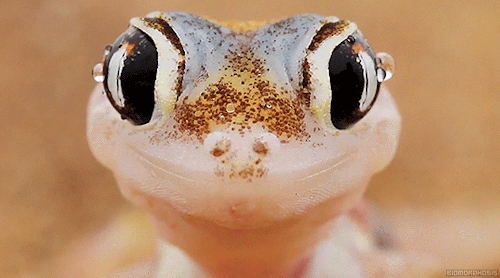
This is a ghostly web-footed gecko, they can be found and perfectly camouflage among the powdery reddish sands of the Namib Desert, their primary habitat.These geckos have adapted their webbed feet not only to help them stay atop, but to bury beneath the dunes of the Namib Desert. Strictly nocturnal lizards, they spend the day in self-dug burrows and emerge at night to feed.
Their bloodshot-looking eyes are massively oversized to help them detect prey, which includes crickets, grasshoppers, and small spiders. They move surprisingly quickly across the sand, and adhesive pads on their toes make them excellent climbers.
People sometimes hunt these tiny lizards for food, and human encroachment is destroying some of its habitat. Their estimated lifespan in the wild is about five years.
22 notes
·
View notes
Note
what are some good lizard facts?
theres a little lizard that lives in the desert and its pink and it has webbed feet so it doesnt sink in the sand and also its very cute. it is called the namib web footed gecko
1 note
·
View note
Photo
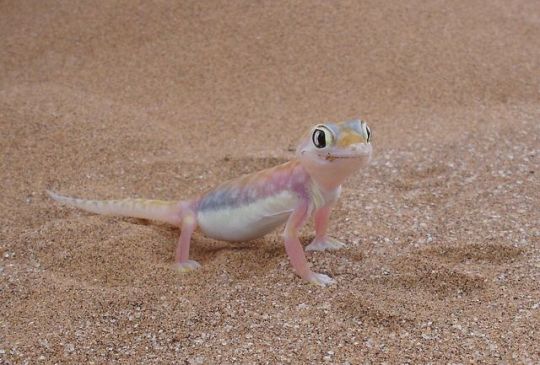
Namib Sand Gecko aka Web-footed Gecko (Pachydactylus rangei), Namibia
Photograph by Stephan Kuemmel | Wikimedia CC
39 notes
·
View notes
Link
Funny animal video - Web Footed Gecko - https://www.onlineseriya.com/2019/03/13/funny-animal-video-web-footed-gecko/ - - Filmed this Web Footed Gecko gecko one foggy morning in the Namib Desert. In order to get moisture they will lick the condensation off their eyes, as this desert can go years without rain. Also called the Palmato Gecko. Likes: 35 Viewed: source
0 notes